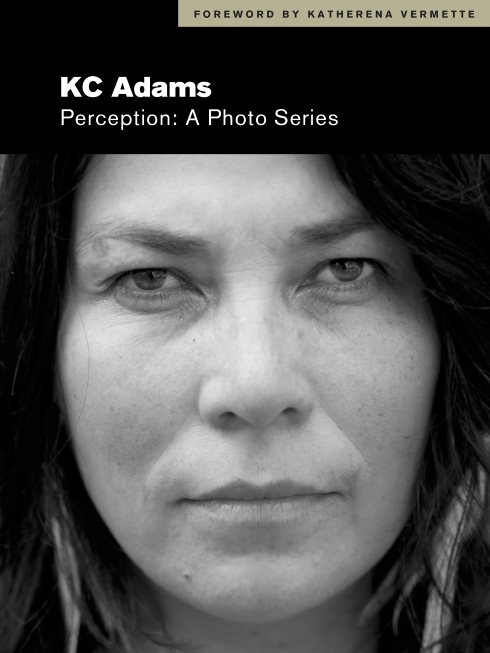
Perception: A Photo Series
Written and photographed by K. C. Adams
Highwater Press, 2019, 120 pp
ISBN 978-1-55379-786-9
While Perception does not fit the literal description of a visual text, it fits the concept of telling a story mainly through pictures. K. C. Adams, an artist and educator from Winnipeg, Canada, tackles racist stereotyping through a series of photographs that were originally displayed on billboards, bus shelters, and posters around the city. This book is a collection of the photos that confronted head-on the disparaging remarks that Métis, First Nations and Inuit hear as they go about their daily lives.
Each page is part of a black and white two-photo study of the emotion that words can engender on a face. The first page in the pair superimposes a racial slur on the photo that captures the emotion the person felt when listening to the word. The slurs are words that Indigenous people frequently hear: welfare mom, government mooch, tax burden, trespasser, hooker, squaw, token Indian, etc. The eyes are pained, lips closed, sometimes with pursed eyebrows, sometimes with a frown, and sometimes with a vacant look. At the bottom of the page is the challenge to look again. The second page is the smile the person feels as they think about a time when they felt affirmed for who they are. Superimposed on the photo are words they use to describe themselves: wife, mother, Sun Dancer, taxpayer, homeowner, professor, Gemini Award winner, soccer player, etc. Their eyes are bright, sometimes crinkly, and smiles are wide. Their faces invite the readers to engage with them, get to know them.
Through these photographs, K. C. Adams confronts stereotyping by documenting in a facial expression the difference between dealing with incorrect perceptions in contrast to descriptions that reflect the real person. In the introduction, Katherena Vermette, a Governor General Literary Award winner for her book of poems North End Love Songs (2012), describes the experience of sitting for the photographs. She relates how, with a few words, K. C. was able to get her to go deep into the experience of walking down the street and being honked and leered at and feeling invisible. Then, in a reversal, she was asked to think about a time she felt loved for who she is. The difference in the facial expressions is what makes this visual essay so powerful. Cathy Mattes, in her critical essay at the front of the book, states that for true reconciliation to occur between Indigenous and non-Indigenous people, we all need to remember “that first glances and opinions are often wrong, limited, or misguided” (p. 20). She cites art scholar Grant Kester who believes that socially engaged art can challenge dominant representations of a community, giving the broader public a more layered or complex understanding of that community, resulting in greater empathy (p. 21). Such is the power of these photographs.
Telling a social story through photos is not new, so pairing K. C. Adams’ work with that of well-known social documentary photographers like Jacob Riis, Lewis Hine or Dorothea Lange works well. Lange’s life and work in particular has been documented for younger readers in Dorothea’s Eyes: Dorothea Lange Photographs the Truth (Barb Rosenstock and Gerard Dubois, 2016), Dorothea Lange: The Photographer Who Found the Faces of the Depression (Carole Boston Weatherford and Sarah Green, 2017), and Migrant Mother: How a Photograph Defined the Great Depression (Don Nardo, 2010). There are equally wonderful books profiling the work of Lewis Hine that prompted Congress to pass child labor laws, or the work of Jacob Riis documenting the inhumane living conditions in immigrant tenement housing.
Book pairs that discuss emotions abound because of the emphasis in education on social emotional well-being. However many are didactic. One that isn’t and engages with the artistic representation of emotions is The Color Monster: A Story About Emotions by Spanish author/illustrator and art therapist Anna Llenas (2018).
K. C. Adams is an award-winning Cree/Ojibway artist based in Winnipeg. Her work can be found in many national and international collections. She was the set designer for the First Nations-inspired Royal Winnipeg Ballet’s Going Home Star: Truth and Reconciliation. She is an instructor in Visual and Aboriginal Art at Brandon University. Her work can be seen on her website.
Susan Corapi, Trinity International University
WOW Review, Volume XII, Issue 4 by Worlds of Words is licensed under a Creative Commons Attribution-NonCommercial-ShareAlike 4.0 International License. Based on work by Susan Corapi at https://wowlit.org/on-line-publications/review/volume-xii-issue-4/10/
WOW review: reading across cultures
ISSN 2577-0527
